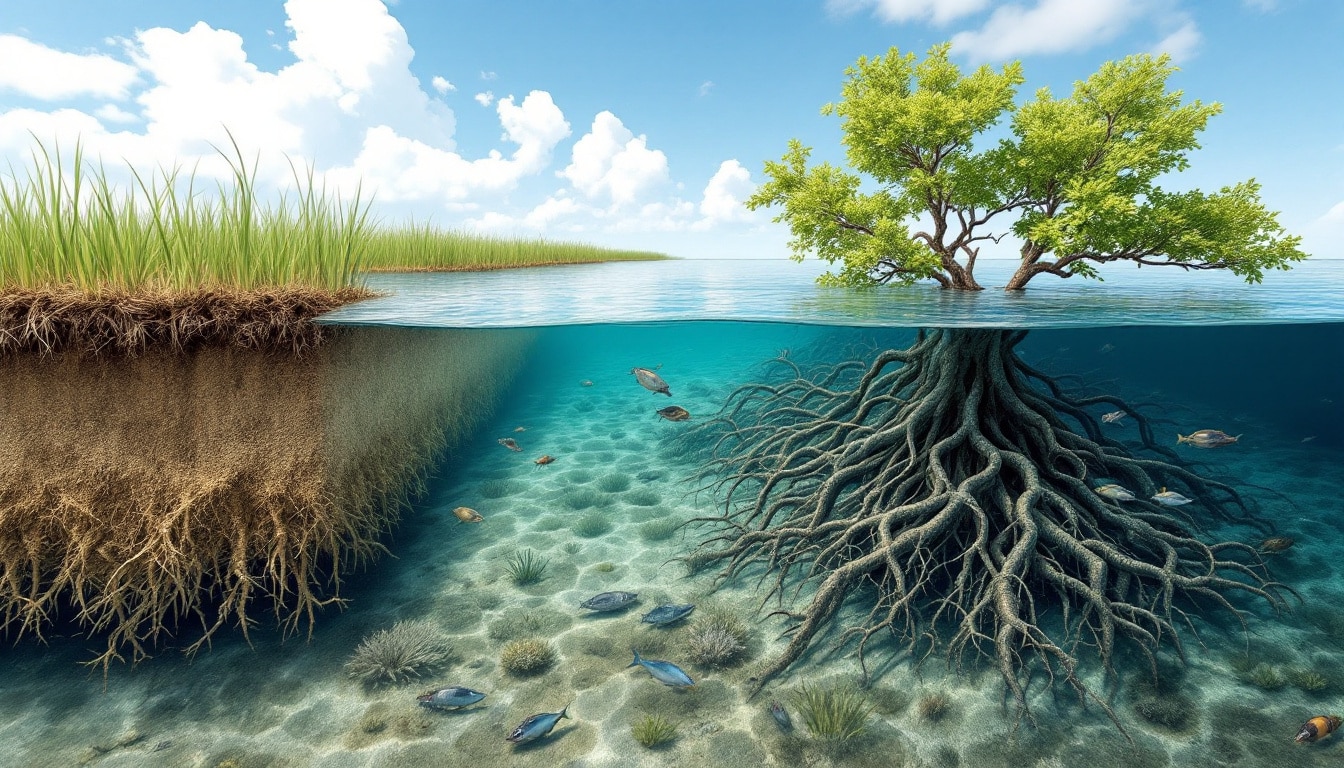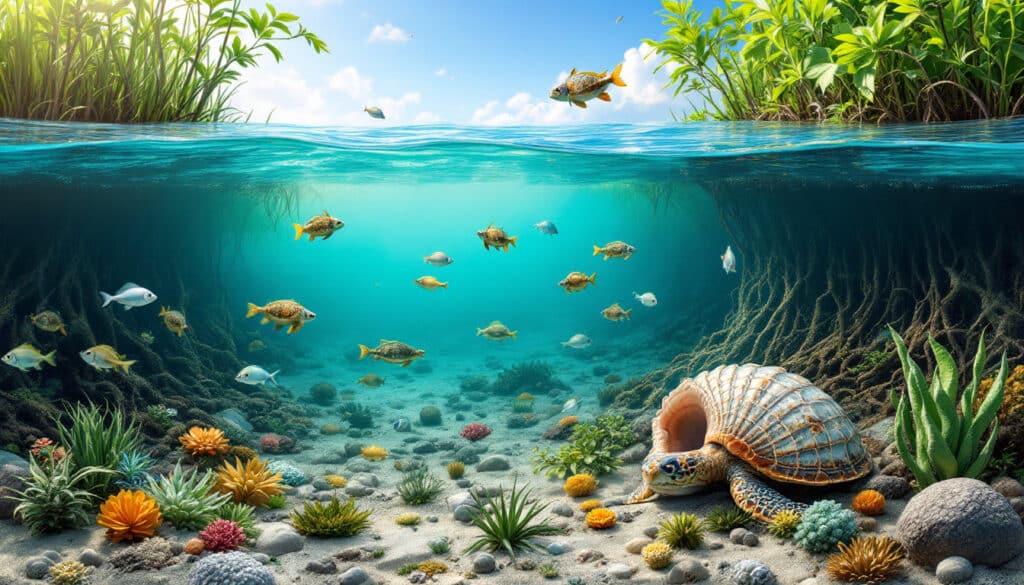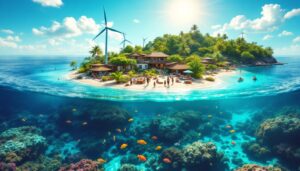Cookies have become essential to ensure the proper functioning of online services. They enable the delivery and maintenance of reliable Google services. Protection against spam, fraud, and abuse is ensured through their use.
Additionally, cookies measure audience engagement and site statistics to understand service usage and improve quality. By choosing “Accept all,” you allow the development and improvement of new services as well as the effectiveness of advertisements. Personalized content and tailored ads are also displayed based on your settings. If you prefer “Decline all,” these additional features will not be activated.

Table of Contents
ToggleIntroduction to macrobenthos communities and Spartina alterniflora
Macrobenthos communities play a crucial role in coastal ecosystems, participating in the decomposition of organic matter, nutrient recycling, and serving as a food base for many marine organisms. Spartina alterniflora, also known as common cordgrass, is a species of marine plant that has often been introduced in various coastal environments due to its ability to stabilize sediments and protect areas from erosion. However, its invasion can lead to significant changes in the structure of benthic communities. Understanding the evolutions of macrobenthos communities during the removal of this species and the restoration of mangroves is crucial for effective marine ecosystem management.
Why is the removal of Spartina alterniflora necessary for coastal ecosystems?
Spartina alterniflora is often introduced for its biomass growth and soil stabilization properties, but its excessive proliferation can harm local biodiversity. The removal of Spartina alterniflora becomes necessary when this plant dominates wetlands, reducing plant species diversity and altering the natural habitat of macrobenthos. By removing this invasive species, the recovery of native biodiversity is allowed, thus promoting the resilience of coastal ecosystems to environmental disturbances. Additionally, reducing the density of Spartina alterniflora can improve conditions for other marine species that rely on a more varied substrate for their survival and reproduction.
What are the impacts of the removal of Spartina alterniflora on macrobenthos communities?
The removal of Spartina alterniflora has direct and indirect consequences on macrobenthos communities. Directly, the removal of invasive vegetation frees up habitat space, allowing for a greater diversity of benthic organisms to establish. Indirectly, the modification of abiotic conditions, such as nutrient availability and water dynamics, influences the composition and abundance of macrobenthos species. Studies have shown that reducing Spartina alterniflora can increase marine invertebrate diversity, thereby promoting more balanced and functionally diverse communities. However, this transition may also lead to temporary fluctuations in the populations of certain species, necessitating ongoing monitoring to ensure a harmonious restoration of benthic communities.
What methods are used to restore mangroves after the removal of Spartina alterniflora?
Mangrove restoration after the removal of Spartina alterniflora involves several methods aimed at re-establishing conditions conducive to the development of native mangrove plants. Common methods include direct replanting of young mangrove seedlings, recycling nutrient-rich sediments, and hydrological management to ensure optimal water flow. Biomanipulation, which involves introducing or fostering key species that facilitate restoration, is also an effective strategy. These methods aim to recreate a favorable environment for mangroves, taking into account the biotic and abiotic factors that influence their growth. Careful planning and adaptive management are essential to overcome challenges related to restoration, such as changing climatic conditions and the ongoing presence of invasive species.
How does mangrove restoration influence macrobenthos communities?
Mangrove restoration significantly impacts macrobenthos communities by promoting diversification and density of benthic species. Mangroves provide complex habitats with tangled roots that offer refuges for many macrobenthos species. Moreover, mangrove vegetation contributes to the enrichment of organic matter, thereby stimulating primary production and supporting more robust food webs. Improved water quality through the natural filtration of particles and nutrients by mangroves creates more favorable conditions for the development of macrobenthos. Furthermore, the restoration of mangroves increases ecological connectivity between different wetlands, facilitating movement and genetic diversity among benthic species. This positive influence enhances the resilience of coastal ecosystems in the face of environmental stressors such as storms and temperature variations.
What challenges are faced during the restoration of mangroves and the management of macrobenthos?
Mangrove restoration and the management of macrobenthos communities present several challenges. One of the main obstacles is the preservation of adequate hydrological conditions, essential for the survival of both mangroves and macrobenthos. Changes in water regimes due to urbanization or human activities can hinder restoration efforts. Additionally, the ongoing presence of invasive species like Spartina alterniflora can complicate the natural regeneration of mangroves and the stability of benthic communities. Climate change, such as sea-level rise and increasing temperatures, imposes additional constraints, requiring flexible adaptation strategies. Furthermore, funding and community engagement are often limited, which can delay or jeopardize restoration projects. Establishing rigorous monitoring and evaluation programs is essential to quickly identify problems and adjust management methods accordingly.
What are the best practices to ensure the success of mangrove restoration and macrobenthos?
To ensure the success of mangrove restoration and macrobenthos communities, several best practices should be adopted. First, an integrated planning approach that considers interactions between biotic and abiotic factors is essential. This includes selecting appropriate sites, ensuring sediment quality, nutrient availability, and favorable hydrological conditions. Second, involvement of local stakeholders enhances community engagement and ensures the sustainable management of restoration projects. Awareness and environmental education initiatives can also mobilize necessary support. Third, using adapted planting techniques and diversifying species contributes to the resilience of restored mangroves. Finally, the implementation of long-term monitoring programs allows for the assessment of intervention effectiveness and adjustments based on observed results. Adopting these best practices fosters the creation of robust and diverse coastal ecosystems capable of supporting healthy and dynamic macrobenthos communities.
Case studies: successes and lessons learned in mangrove restoration
Several case studies illustrate the successes and challenges encountered in mangrove restoration and the impact on macrobenthos communities. For example, a restoration project in the Gulf of Mexico demonstrated that the removal of Spartina alterniflora followed by the planting of native mangroves led to a significant increase in macrobenthos diversity. Students from the local university, involved in the project, observed improvements in water quality and a greater abundance of hartias and benthic crustaceans. Another study, conducted in Southeast Asia, highlighted the importance of community engagement in the success of restoration projects. Local coastal communities played a crucial role in monitoring and managing the restored mangroves, ensuring the sustainability of the efforts made. However, these case studies also reveal important lessons, such as the need to adapt restoration techniques to the specific conditions of each site and the importance of adaptive management to respond to unforeseen environmental changes.
What is the future of research on macrobenthos and mangrove restoration?
The future of research on macrobenthos communities and mangrove restoration looks promising, with an increasing focus on multidisciplinarity and technological innovation. Scientists are exploring new biological monitoring methods using advanced technologies such as remote sensing and underwater sensors to obtain more accurate data on the dynamics of macrobenthos and the evolution of restored mangroves. Additionally, genomics and biotechnology provide tools to better understand the interactions between benthic species and mangrove plants, facilitating the development of more targeted management strategies. Future research will also focus on adapting to climate change, assessing how restoration projects can be designed to enhance the resilience of coastal ecosystems to environmental stressors. Lastly, enhanced collaboration among researchers, natural resource managers, and local communities will be essential to translate scientific discoveries into effective management practices, thus ensuring the sustainability of mangrove restoration efforts and the health of macrobenthos communities.









